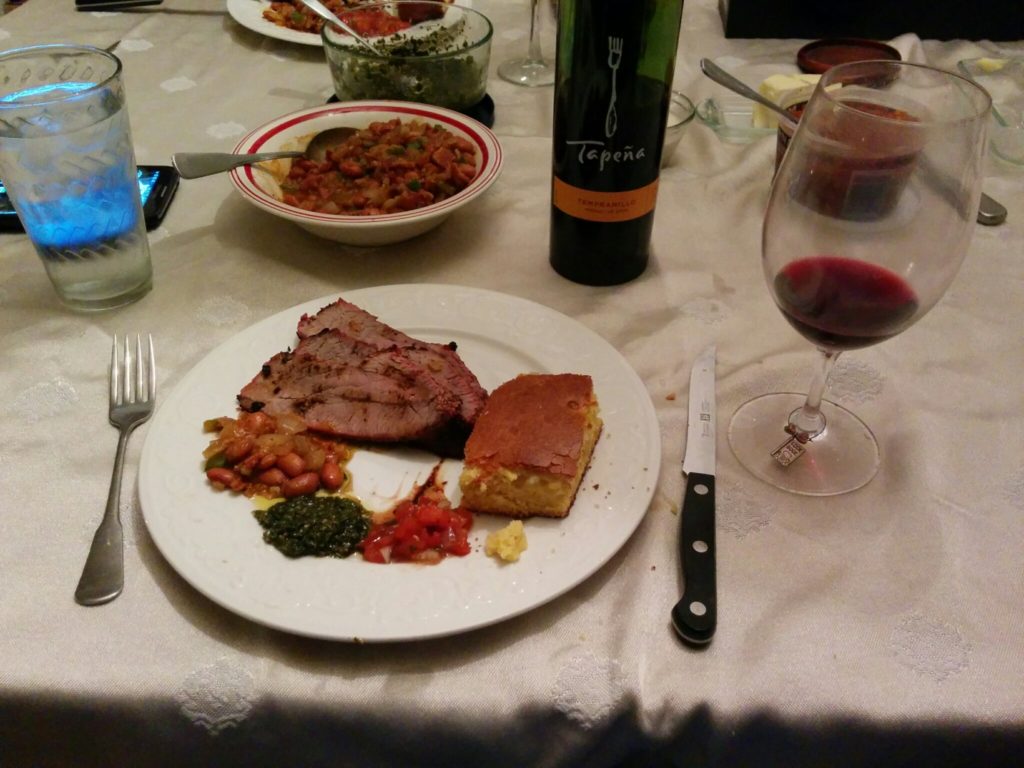Santa Maria-style Tri-Tip
I came across a couple references of how the vaqueros (Mexican cowboys) were given the tri-tip of the cow to eat since it wasn’t a desirable cut at the time. They’d often cook it on a spit and serve a bunch of stuff to put on it for extra kick.
Well, I have a Weber with a rotisserie ring so it’s right up my alley. Not that direct on the grate is bad, just turn it more often

Shopping List: (for four)
- Tri-Tip (about 8oz per person)
- Oak chips for the BBQ – soak for at least an hour, preferably two beforehand
- 1 tsp Salt
- 2 tbsp Pepper
- 2 tbsp Garlic Garni (powdered garlic, salt, parsely, onion, and a few other things I haven’t sorted out)
- 4 tbsp canola or vegetable oil
- a couple of salsas and/or savory relishes
I’ll skip the boring (for most of you) bits about the history of the tri-tip cut and how it was a staple for the vaqueros that ran cattle throughout California, because that’s not wholly important. I should get down to the meat. So first, I’d like talk about fire. Fire and smoke are pretty key here, Oak is great for adding smoke, but I happened upon some chips that were made from old wine barrels which is even better.
(For what it’s worth, I’ll mention that lots of folks seem to do this right on the grate, but the vaqueros – there’s your history part – did it on a spit, and I think for good reason)
First, get some oak chips soaking in water for at least an hour. This allows the wood chips to get smoky but not burny.
Next, season the meat. We’re going to do a basic dry rub. Nothing fancy, really. A couple of palms of salt, pepper, and though the recipe I started with called for garlic salt, I used this stuff called ‘Garlic Garni’ that’s put together down in Gilroy, CA (arguably the garlic capitol of the world).
I like to give the meat a quick rub with canola oil (you can use other oils, but make sure they have a high flash point) then rub the seasonings in good, and then follow it with another slathering with oil.
And, as soon as the fire is ready, let’s deal with the meat. I like to pull my meat off the grill at around 130 degrees, so that comes out fairly rare once it’s rested 5-10 minutes. 135 is going to give you a pretty medium-done, but it’s a juicy medium, so don’t sweat it too much.
Pretty straight-forward, right? Well, to really kick things up a notch, serve with an assortment of relishes, chutneys, and salsas. Anything with a good earthy base works best or it’ll be too sweet for the meat.
Universal favorites here are a pinto bean relish and mango salsas. The big thing is to think about what would taste good on steak. As such, I recommend staying away from the pico de gallo type salsas because they’re too “bright”.
- Side note: if you’re serving this for a party, invite everyone to bring their favorite topping given the above critera. It allows everyone to contribute, and at the same time reduces the amount of cooking you have to do 🙂
As far as plating goes, a good rustic bread or iron-cooked cornbread are good for a starch. Spanish rice also goes well. For veg, my favorite is green beans tossed with a bit of butter and bacon grease.